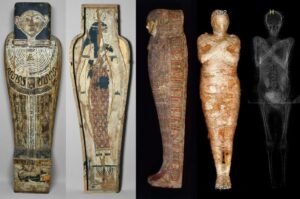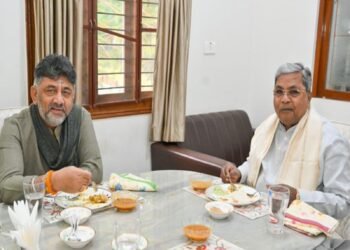The Warsaw Mummy Project made headlines in 2021 by announcing the discovery of a fetus inside an ancient mummy. Now, a team of radiologists and mummy experts refutes these claims, stating that no fetal skeleton exists and that the original study may have been driven by sensationalism rather than evidence.
BY PC Bureau
A new study has challenged the claim that an ancient Egyptian mummy, known as the Mysterious Lady, died while pregnant and suffering from throat cancer. The authors of this rebuttal argue that the supposed fetus was actually embalming material inserted by ancient morticians, while a misinterpretation of skull damage led to an erroneous cancer diagnosis. They accuse the original research team of sensationalizing their findings without sufficient evidence.
The Mysterious Lady, brought to Poland in the early 1800s, is currently housed at the National Museum in Warsaw. In addition to, cause of death, there is a lot of confusion around the exact origin of the mummy as little is known about her whereabouts before it landed at the museum in Warsaw. The origin of the coffin, from where it was first unearthed, is still a mystery.
In 2021, researchers from the Warsaw Mummy Project published a study claiming that CT scans revealed the presence of a fetus between 26 and 30 weeks old within the mummy’s remains. Shortly afterward, they suggested that a void in the skull was evidence of a cancerous tumor that may have caused her death.
ALSO READ: Inside Insein: Journalist Faces Hidden Horrors of Myanmar’s Most Infamous Prison
The study has been pubished in Archaeological and Anthropological Sciences. The previous of the article says: The collective international case study of a mummy presented in this paper is to our knowledge the first of its kind. At its core is an independent reassessment, by acknowledged professionals, of radiological material from a mummified woman (now in Warsaw) who had been claimed to have been pregnant and suffering from a neoplastic condition. Despite two studies dismissing these claims on scientific grounds, both the pregnancy and the cancer theories were repeated and sustained, overwhelming any opposing opinions in the matter. A media sensation only contributed to this. Using a cloud-based platform, the participants reexamined the original radiological data, responding to a survey questionnaire prepared for the purpose. Their independent responses consistently upheld the absence of any indications of either a fetus or cancer in the subject of study. The joint case study also provided opportunity for additional individual analysis of the last points raised by the authors of the pregnancy theory, which were dismissed as well. However, efforts at a comprehensive explanation of the pelvic contents, involving identification of the inserted material, did not prove conclusive and will be continued. Addressing issues of responsible science, a part of this study atypically concerns the role of popular media, which in this particular case affected even the scientific approach, not to mention public reception. The study is another strong call for an interdisciplinary approach in bioarchaeology, particularly in mummy studies.

ALSO READ: Trump Administration Shifts U.S. Policy on Ukraine, Opposes UN Measure
The new study’s authors argue that scientific debate has been compromised by widespread media fascination with the idea of a “pregnant mummy,” despite the claims not being verified by a radiologist—standard practice in such cases. “The case of [the] Warsaw mummy—pregnant or not? Terminally ill with cancer or not?—has generated such extensive media attention that the process of rigorous scientific debate, which strives to achieve objectivity in an effort to arrive at the truth, has become compromised,” they write.
One of the rebuttal’s authors, described as a “paleoradiologist and mummy expert” specializing in fetal imaging, had previously pointed out that no fetal skeleton was visible inside the mummy. In response, the Warsaw Mummy Project researchers argued that the bones had likely dissolved due to natural acids. Unsatisfied with this explanation, the skeptics sent the original CT scans of the Mysterious Lady to ten independent radiology experts worldwide, along with a questionnaire regarding their interpretations.
According to the new study’s authors, all ten experts were unbiased, except for one who had been involved in the Warsaw Mummy Project’s original research. “All ten respondents indicated clearly that there was no evidence of a fetus in the pelvic area,” the authors write. “Not one marked the answer ‘There is evidence to support the presence of a 26–30 week fetus’ or else expressed any doubt (no one indicated ‘Fetus can be neither confirmed nor excluded’).” Instead, they concluded that the supposed fetus consisted of “packs” of unknown substances placed inside the body during embalming.
The study also refutes the claim that the woman had throat cancer. None of the independent reviewers found signs of the disease, despite the presence of lesions within the skull. Only one expert suggested that cancer could neither be confirmed nor ruled out, but even they stated that the most likely explanation for the markings was damage caused during the removal of the brain in the mummification process.
Countering these findings, Warsaw Mummy Project researchers Wojciech Ejsmond and Marzena Oarek-Szilke told IFLScience that they are aware of the lack of consensus regarding what is inside the pelvis of the Mysterious Lady. They acknowledge that interpretations range from embalming materials to viscera or a tumor but maintain that their pregnancy hypothesis was reviewed and supported by gynecologists and obstetricians, making it a legitimate theory. “The fact that other experts have different interpretations is expected,” they say.
Regarding the cancer claim, they assert that their hypothesis was based on consultation with Prof. Rafa Stec, an expert in the field, but emphasize that it remains a working theory.
The authors of the new study conclude that, based on the collective expertise of multiple international specialists who analyzed the radiological material, the mummy contains neither an intrauterine fetus nor traces of a cancerous tumor. They criticize the Warsaw Mummy Project for attempting to “steal the show” with unverified claims and accuse the media of amplifying a misleading narrative.
However, Ejsmond and Oarek-Szilke argue that the new study selectively quotes their statements and that its authors only had access to fragments of the mummy’s CT scans, limiting their ability to make definitive conclusions. They further contend that the new analysis references only select parts of their conference papers that support its position, ignoring other findings.













